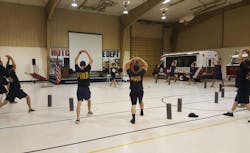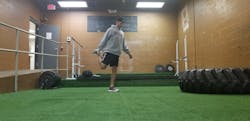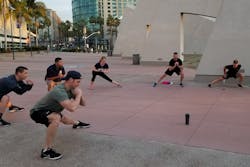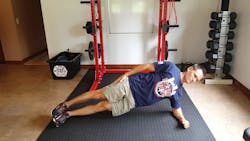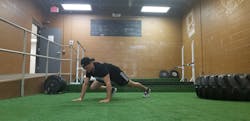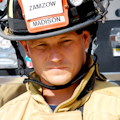Injuries are going to occur on (and off) the fireground. If you don’t believe me, look at the statistics published by the NFPA every year. The latest report indicates that there were over 60,000 firefighter injuries in 2015. And keep in mind that these are only the “reported” injuries. We all know that many firefighters don’t report their injuries for a variety of reasons, sometimes out of fear of being pulled off the line or because they simply don’t think the injury warrants a report.
Even the most prepared firefighter will face situations that cause trauma to the body—and the body can only take so much. In most cases, it’s not “if” an injury will occur but rather “when.”
The good news about injuries is that there are some ways to prevent them from wreaking havoc on your career and life. Twenty-five years of working in the fitness and fire service industries has helped me develop this list of five keys to firefighter injury prevention. Following these suggestions won’t guarantee an injury-free shift or career, but it will help minimize your risk.
1. Stretch
A note about warm-ups: Traditional workouts routinely include static stretching before activity. Static stretching means holding a target muscle in a stretched state without movement for a period of time, usually around 15–30 seconds. A couple of the most recognizable static stretches are the sitting toe reach and the standing quadriceps stretch in which you pull your ankle behind your leg.
Over the years, research has discovered that this stretching method can be effective, but not before a workout or training. I’m not saying that static stretching has no benefit. It feels good to stretch and, if done correctly, you can gain flexibility. For example, if you lack the flexibility in the hips and ankles to properly perform a squat correctly, then a daily stretching routine after a workout or proper warm-up would help you gain flexibility in these areas. But the key is to perform this stretching after a workout or a proper warm-up.
Some great dynamic movements are lunges with a twist, pulling your knees to your chest, arm circles and bodyweight squats. A proper warm-up should take between 10 and 15 minutes, which is one major reason why people often skip it and dive right into their exercise or activity. Keep in mind that starting a workout or training with “cold” muscles can lead to injury, so don’t skip this vital step.
2. Be proactive
“Prehab” is a common practice in the athletic training world. Prehab is a proactive approach to avoiding pain and injury and includes any and all exercises, practices and routines that prevent one from getting injured and needing rehabilitation.
A great way to prehab is to perform corrective exercises that help build strength and stability around your most vulnerable areas, while improving mobility, balance and joint function to decrease the potential for injuries. In other words, don’t wait until you’re injured to do rehab exercises. Try to incorporate movements that will strengthen the more commonly injured joints—knees, shoulders and back. After all, why wait until you injure your knee to do balancing exercises? Perform exercises that will strengthen your knees and the surrounding muscles.
3. Work your core
Back problems are among the most expensive of musculoskeletal disorders and one of the most common work-related ailments affecting adults in the United States. As might be expected, firefighters are at increased risk of back injury compared to other professions due to the rigorous physical requirements of the occupation. The International Association of Fire Fighters’ annual Death and Injury Survey reveals that sprains and strains routinely account for approximately 50 percent of all line-of-duty injuries, and back injuries account for approximately 50 percent of all line-of-duty injury retirements each year. These back sprains result in significant lost time and medical expense.
With this in mind, a great way to prevent injury, especially to the back, is to incorporate core exercises that strengthen through all planes of motion. A preventive core routine for firefighters should include planks and, more importantly, side planks and other exercises that improve stamina of the lower back and glute muscles.
4. Practice like you play
5. Focus on good posture
Good posture does not immediately come to mind when we think of ways to avoid injuries. However, correct alignment of the neck and shoulders goes a long way in preventing overuse injuries of the shoulders, as well as acute and chronic neck pain. Maintaining correct alignment is difficult because life activities—driving, computer usage, wearing a helmet and wearing heavy gear—tend to pull us forward at the head and shoulders.
With the shoulders in proper position, less stress is placed on the rotator cuff and biceps tendon, therefore reducing the incidence of shoulder injury. Good posture includes a relaxed neck with shoulder blades down and back. This position gives maximum stability to the shoulder joint and lets the muscles of the rotator cuff function optimally. Practice maintaining the shoulder blades in this position while you do activities on the fireground and/or gym.
To decrease stress and injury at the neck, in addition to reducing the chance of shoulder injury, the head must be held in the proper position. The back of the neck should be elongated with the chin tucked. When the head is held in a forward position, muscles are constantly contracting to keep the head upright against the force of gravity. This position is especially damaging when wearing a helmet. When the head is in line with the shoulders, gravity is neutralized, taking the stress off of the cervical muscles. Make a conscious effort to keep your neck and shoulders in good alignment, and take note of the posture of others around you, because that will often serve as a good reminder to maintain proper alignment.
In sum
In the fire service, we are taught to minimize the risks. This also should be the mentality when it comes to injury prevention. Although there’s no guarantee that we’ll have an injury-free career, there are things we can and should do to give ourselves the best possible chance of achieving that.
Make time to stretch, take a proactive approach to your fitness, work your core, practice like you play, and sit up straight with good posture. You owe it to your crew, family and community to stay healthy, and incorporating these simple tasks can help you stay healthy and serve your department. After all, it’s hard to serve from the sidelines.
Resources
Bay Sports. “Good Posture Avoids Sports Injuries.” baysport.com/blog/good-posture-avoids-sports-injuries.
Gummelt, D. “The Impact of Flexibility Training on Performance.” American Council on Exercise. August 2015. tinyurl.com/ACE-flex.
IAFF. “Back Injuries and the Fire Fighter.” iaff.org/hs/Resi/BackPain.asp.
Moore-Merrell, L., Zhou, A, et al. “Contributing Factors to Firefighter Line-of-Duty Injury in Metropolitan Departments in the United States.” 2008. tinyurl.com/LODI-IAFF.
Sell, K. “Firefighter Perceived Fitness: Implications for Injury Risk and Training Program Development.” National Strength and Conditioning Association. May 2015. tinyurl.com/NSCA-Injury-Prevention.
About the Author
Aaron Zamzow
Aaron Zamzow is a firefighter/training officer for Madison, WI, Fire Department. He holds a bachelor’s degree in health/wellness and has 20 years of experience as a fitness trainer. He created Fire Rescue Fitness and authors programs that are aimed at getting fire rescue athletes fit for duty.
